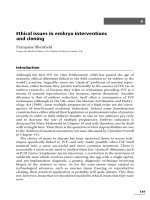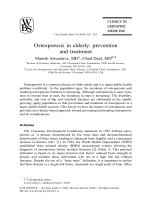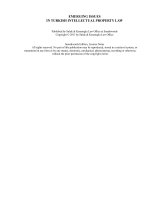Cooperative Financial Institutions Issues in Governance, Regulation, and Supervision potx
Bạn đang xem bản rút gọn của tài liệu. Xem và tải ngay bản đầy đủ của tài liệu tại đây (2.13 MB, 74 trang )
THE WORLD BANK
Carlos E. Cuevas
Klaus P. Fischer
WORLD BANK WORKING PAPER NO. 82
Cooperative Financial Institutions
Issues in Governance, Regulation, and Supervision
36810
WORLD BANK WORKING PAPER NO. 82
Cooperative Financial
Institutions
Issues in Governance, Regulation,
and Supervision
THE WORLD BANK
Washington, D.C.
Carlos E. Cuevas
Klaus P. Fischer
Copyright © 2006
The International Bank for Reconstruction and Development/The World Bank
1818 H Street, N.W.
Washington, D.C. 20433, U.S.A.
All rights reserved
Manufactured in the United States of America
First Printing: June 2006
printed on recycled paper
1 2 3 4 5 09 08 07 06
World Bank Working Papers are published to communicate the results of the Bank’s work to the
development community with the least possible delay. The manuscript of this paper therefore
has not been prepared in accordance with the procedures appropriate to formally-edited texts.
Some sources cited in this paper may be informal documents that are not readily available.
The findings, interpretations, and conclusions expressed herein are those of the author(s)
and do not necessarily reflect the views of the International Bank for Reconstruction and
Development/The World Bank and its affiliated organizations, or those of the Executive Directors
of The World Bank or the governments they represent.
The World Bank does not guarantee the accuracy of the data included in this work. The
boundaries, colors, denominations, and other information shown on any map in this work do
not imply any judgment on the part of The World Bank of the legal status of any territory or
the endorsement or acceptance of such boundaries.
The material in this publication is copyrighted. Copying and/or transmitting portions or all
of this work without permission may be a violation of applicable law. The International Bank
for Reconstruction and Development/The World Bank encourages dissemination of its work
and will normally grant permission promptly to reproduce portions of the work.
For permission to photocopy or reprint any part of this work, please send a request with
complete information to the Copyright Clearance Center, Inc., 222 Rosewood Drive, Danvers,
MA 01923, USA, Tel: 978-750-8400, Fax: 978-750-4470, www.copyright.com.
All other queries on rights and licenses, including subsidiary rights, should be addressed to
the Office of the Publisher, The World Bank, 1818 H Street NW, Washington, DC 20433, USA,
Fax: 202-522-2422, email:
ISBN-10: 0-8213-6684-X ISBN-13: 978-0-8213-6684-4
eISBN: 0-8213-6685-8
ISSN: 1726-5878 DOI: 10.1596/978-0-8213-6684-4
Cover photo of Ghanaian women making payments by Ingrid Hesling, courtesy of Photoshare.
Carlos E. Cuevas is Adviser in the Financial Sector Operations & Policy Department of the
World Bank. Klaus P. Fischer is a Professor of Finance at Université Laval.
Library of Congress Cataloging-in-Publication Data has been requested.
Contents
Abstract v
Preface vii
Abbreviations and Acronyms ix
1. Introduction 1
2. Governance and Risk 5
Strengths 6
Weaknesses: The Sources of Default Risk in a CFI 7
3. The Macro-governance 15
Core Competences and the Search for Alliances 15
Empirical Tests 23
The Design and Evolution of Networks of CFIs 24
4. The Legal Environment 27
The Roots of Cooperative Laws 27
The NGO Movement Makes Its Appearance 29
The Forces of Change 30
CFI Laws and Banking Laws 32
Guidelines for and Models of CFI Laws 33
Marry the Legal Framework of CFIs and NGOs? 35
Common and Other La 35
5. The Regulatory Framework 37
A Review of the Main Issues 37
The Debate over Delegated and Auxiliary Supervision 40
Cost of Supervision: Who Should Bear It? 47
Towards a Set of “Core Principles” of CFI Regulation and Supervision 48
Appendix 51
Global Overview
Major Developed Country Systems and International Networks 54
Cooperative Financial Institutions and Outreach to the Poor 54
References 57
iii
ws
51
LIST OF TABLES
1 Summary of Agency Conflicts by Institution 12
2 Classification of Regulation and Supervision Approaches 45
LIST OF FIGURES
1 Mechanisms to Enforce Contracts in a Firm 4
2 Stakeholder Conflicts in a CFI 9
3 The CFI as a Financial Services Production Unit 17
4 CFI Networks as Input Pooling Alliances 18
5 Organization of the Typical Network 21
A.1 Cooperative Financial Institutions: Selected Indicators 1996–2003 52
A.2 Market Penetration Ratios: Clients, Loans, Savings 53
A.3 Growth in Penetration Ratios, 2002–2003 53
LIST OF BOXES
1 What Do We Mean By “CFI”? 2
2 Delegated/Auxiliary Supervision 41
iv Contents
v
Abstract
T
he paper addresses topics on which an agreement is necessary to arrive at consensus
guidelines or “principles” of regulation and supervision of cooperative financial insti-
tutions (CFIs) in developing countries. Specifically we identify those aspects related to CFI
industry structure, governance, legislation and regulation over which a well established
base of knowledge exists; we point out the most important gaps in understanding and those
over which a considerable degree of disagreement among stakeholders appears to exist and
that require research to consolidate opinions. Three main topics covered are: (i) the fun-
damental structure of the sector in terms of its internal (micro) and inter-CFI (macro)
organization, with focus on the agency conflicts inherent in the mutual structure, the extent
to which they contribute to failure risk, and to whether and how these conflicts are controlled
by existing governance mechanisms; (ii) the existing legal frameworks in an international
context, their origins and the implications for the functioning of CFIs; and (iii) the regu-
latory frameworks under which CFIs operate and the different propositions by stake-
holders about what should be an appropriate regulatory framework and an effective
supervision mechanism.
The main propositions that emerge from the paper requiring verification are the
following:
1. The CFI present advantages over investor-owned financial intermediaries in the
provision of financial services through breaking the market failure that leads to
credit rationing, thus contributing to a “functional financial system” in the sense of
Merton and Bodie (2004).
2. (By extension of 1) a financial system that presents a diversified institutional struc-
ture, including institutional types, among other CFIs, will be more efficient in pro-
moting economic growth and reduced poverty.
3. Expense preferences (EP) by managers—or equivalently the member-manager
conflict—is the principal source of CFI failure. Control of expense preferences should
be a central theme of prudential supervision of CFIs.
4. Inter-CFI alliances (federations, leagues,and so forth) are hybrid organizations that
allow CFIs to exploit economies of scale and manage efficiently uncertainties in the
procurement of intermediation inputs. Thus, the legal framework should facilitate
the formation of such alliances and provide legal support to the inter-cooperative
contracts that result.
5. Inter-CFI alliances that include private ordering mechanisms and separate strategic
from operational decisionmaking between the base units and the apex contribute
to the control of expense preference, thus enhancing the resiliency of the system to
failures and crisis.
6. Mutual financial intermediaries require a specialized regulatory environment that
supports the special nature of the contracts imbedded in the institutions.
7. Indirect supervision (auxiliary/delegated) is a powerful tool to: (i) adapt super-
vision to specific needs of the CFI; (ii) facilitate integration of the CFI to a
vi Abstract
supervision environment with financial sector standards; and (iii) encourage
integration.
8. Tiering (splitting) the CFI sector into two groups, one being a large/open CFIs
under banking authority supervision and another a small/closed CFI, is (is not) a
reasonable strategy to creating an appropriate regulation and supervision (R&S)
environment for CFIs.
vii
Preface
T
his paper is a product of ongoing work on Cooperative Financial Institutions at the
Financial Sector Operations and Policy Department of the World Bank. The views
expressed in the paper are those of the authors and not necessarily those of the World Bank
or its affiliate institutions. The authors gratefully acknowledge valuable and elucidating
comments on earlier drafts from Messrs/Mmes. Brian Branch (World Council of Credit
Unions), Anne Gaboury (Développement international Desjardins), Renate Kloeppinger-
Todd and Andre Ryba (both World Bank), and from participants at an IMF/MFD Seminar
in November 2005. Remaining errors and opinions, however, are sole responsibility of
the authors.
ix
Abbreviations and Acronyms
AH Appropriability hazard
ATM Automatic teller machine
BCBS Basel Committee of Bank Supervision
BCC Banco de Crédito Cooperativo
BCC (Peru) Banco Central Cooperativo (Peru)
BoD Board of Directors
CFI Cooperative financial institution
CGAP Consultative Group to Assist the Poor
COFAC Cooperativa Nacional de Ahorro y Crédito
CPM Caja Popular Mexicana
CUSOs Credit Union Service Organizations
DGRV Deutschen Genossenschafts- und Raiffeisenverbands
(German Confederation of Cooperatives)
DID Développement International Desjardins
EEC European Economic Community
EP Expense preferences
FC Financial cooperative
IAS International Accounting Standards
IBDA International Bond Dealers Association
ICA International Cooperative Alliance
IDRC International Development Research Centre
IFAD International Fund for Agricultural Development
IFRIC International Financial Reporting Interpretations Committee
ILO International Labour Office
IRU International Raiffeisen Union
ISDA International Swap Dealers Association
NCUA National Credit Union Administration
NGO Non-Government Organizations
NIE New Institutional Economics
PAMECAS Programme d’appui aux mutuelles d’épargne et de crédit au Sénégal
PARMEC Projet d’appui à la réglementation sur les mutuelles
d’épargne et de crédit
R&S Regulation and supervision
TCE Transaction costs economics
UCONAL Unión Cooperativa Nacional
UK United Kingdom
WOCCU World Council of Credit Unions
WSBI World Savings Banks Institute
CHAPTER 1
Introduction
“Subject to little, if any, pressure from savers, management is a self-perpetuating
autocracy.”
—Nicols (1967: 337)
“In terms of supervision equal treatment does not mean uniform treatment
but non-discriminatory treatment which recognizes the distinct character of
cooperatives.”
—United Nations (2003) report (p. 10).
C
ooperative financial institutions (CFIs), albeit highly pervasive in most countries,
are among the poorly understood entities that comprise the existing institutional
base for financial intermediation. CFIs include diverse member-owned financial
intermediaries referred to as credit unions, savings and credit cooperatives, cooperative
banks, and other terms that differ across regions of the world.
1
Their institutional struc-
ture and governance, legal and regulatory status, and scale and services portfolio also vary
widely across regions and especially between industrialized countries and developing
economies. A most basic common denominator is that they collect deposits and do business
often solely with members.
2
Existing literature already supports the notion that CFIs serve
many poor people, even though middle-income clients are also among their membership, a
feature that in fact allows CFIs to reach poor segments of the population without neces-
sarily compromising their sustainability. In many cases CFIs serve larger numbers of poor
people than specialized (“targeted-to-the-poor”) microfinance institutions, without rely-
ing on donor support as the latter do.
3
1
1. For example, Savings and Credit Cooperatives (SACCOs) in East Africa; “Caisses populaires” or
“Caisses d’épargne et de crédit” in West and Central Africa; “Cooperativas de ahorro y crédito” or “cajas
de ahorro y crédito” in Latin America; credit unions in the UK, USA and parts of Canada.
2. Although in some cases they also serve non-member users; the distinction between members and
non-members is often a small share purchase.
3. See Appendix for a more extensive background on CFI.
Why an issues paper on governance, regulation, and supervision? First, because lack
of knowledge of these matters has been a recurrent obstacle in development finance, result-
ing in widespread neglect of the CFI sector in spite of its pervasiveness and potential. Sec-
ond, because there are topics related to organization, governance, legislation, regulation,
and supervision of cooperative financial institutions over which there is no agreement but
over which one is needed if we are to facilitate the growth of these institutions and realize
their potential for serving the poor. The “issues” are not about the (group of) ratio(s) to
use in inspection, or whether there should be an early warning system in place, or how
much provisioning to make on how many months of interest arrears, or the frequency for
site-inspection, or the content of an audit report and many other technical details per-
taining to the monitoring of CFIs. Over these points a group of experts could rapidly con-
verge on opinions and make well thought-out recommendations. On these points most
internationally known technical advisers (DGRV, DID, WOCCU, and others) usually have
precise opinions and schemes, and they are all reasonable and well thought out. The true
“issues” over which large disagreements exist are not those. They address more funda-
mental questions such as: what are the main strengths and weaknesses of CFIs, what is the
role of integration (in networks), how much of it is good and should it be encouraged, what
is the role of the legal framework in doing this, should the legal framework be a specialized
one covering uniformly all CFIs or should the system be tiered, should CFIs fall under
banking authority supervision—most agree that yes, it should—but then how: direct, del-
egated or auxiliary supervision? And what are the differences, if any, between these schema,
and the effects they have on performance of CFIs? What should the role of the sector itself
be in the design and implementation of any new legal or regulatory framework?
Addressing these issues is fundamental. The best implemented CFI management and
control systems may be rendered useless by a flawed regulatory framework. What is the
2 World Bank Working Paper
Box 1: What Do We Mean By “CFI”?
Under the term CFI (cooperative financial institutions) we include institutions that bear different
names but are essentially identical. Only in few cases do they have special organizational features.
The most common expressions used for CFI are financial cooperative (FC) with it Spanish transla-
tion cooperativa financiera, savings and credit cooperative (SACCO) with its Spanish translation
cooperativa de ahorro y crédito, CAC or COPAC, and credit union (CU) with its Spanish translation
union de crédito. There are also the non-English expressions such as the French caisse with its
variations—agricole, populaire, mutuelle—of which populaire is probably the most common, with
its Spanish translation of caja or in Portuguese caixa. Under CFI we also include a number of insti-
tutions known as cooperative banks (CB). The expression cooperative bank is often used to rep-
resent a CFI that holds a banking licence, but also a number of other very disparate structures,
such as: the apex of a CFI network that holds a banking licence (Germany, Colombia); a joint stock
banking subsidiary of an apex of a CFI network (Brazil, Finland); a joint-stock bank subsidiary of
an apex of a non-financial cooperative network (U.K., Swizerland); or an entire network of CFI,
usually with a relatively high level of integration that holds a banking licence (Netherlands’
Rabobank). On the other hand, the expression caisse, caja, caixa is also often used to represent
what in English is know as a “savings and loans association” (S&L) of mutual ownership, which are
strictly speaking not cooperatives. These latter are not the subject of this document although we
refer to them in several occasions.
good of having excellent management tools implemented if suddenly the banking author-
ity demands that the minimum capital of a CFI must be US$5.0 or 10.0 million and that
reports must include values for 1500 accounting items as all the rest of the investor-owned
banking system (such as Argentina, Uruguay, Colombia)? Or the central cooperative bank
of a network fails, with the concomitant loss of substantial investments (Colombia, Costa
Rica)? Or the banking authorities consistently refuse to take charge of the supervision of
the sector (Nicaragua)? What good is it to implement a “delegated monitoring system” if
it is riddled by interest conflicts that make it totally ineffectual? What if there are sound
economic arguments, and experiences, that support the notion that this is an effective
mechanism that overcomes banking authority reticence to engage in CFI supervision in
addition to facilitating several other positive developments?
Thus, the goal of this issues paper is to address directly those topics on which no agree-
ment exists but over which an agreement is necessary to arrive to some consensus “guidelines,”
or even better “core principles,” of regulation and supervision (R&S) of CFIs in develop-
ing countries, something that exists now for over seven years for the investor-owned
banking system.
To assess the specific needs in terms of R&S of CFIs we will make three fundamental
assumptions:
1. Using principles of agency theory we view the institutions as bundle of contracts
between different principals and agents. Failures result from situations where agency
conflicts reach unsustainable levels that put the stability of the institution in peril.
This includes an analysis of the governance structures build within and between CFIs
and their degree of efficiency in controlling conflicts between contracting parties and
to facilitate its role to deliver financial services to members.
2. Employing an “incentive-conflict justification for regulation” approach, we assess
the needs of regulatory intervention to increase fairness, efficiency, and enforceabil-
ity of contracts, and reduce failure risk by focusing on those agency conflicts among
all possible candidates that contribute most to that risk.
4
3. Regulation is viewed as a mechanism to control agency conflicts that complements
three other mechanisms: internal (governance bodies, design of contracts), market
based (prices of shares, market for corporate control), and private ordering mecha-
nisms used by bureaucracies to whom the enterprise may belong (trade association,
auto-regulatory body or alliance). These four mechanisms, as shown in Figure 1, act
in complementary fashion, the higher the efficiency of one, the lower will be the mar-
ginal contribution of the other three to control the conflict.
Thus, to analyze the specific needs of CFIs in terms of a regulatory response by the state we
employ a theoretical framework that is based on the following central idea: financial regulation
exists to insure that contracts between stakeholders of an institution are fair, efficient, and enforce-
able. A reliable regulator can improve the fairness, efficiency, and enforceability of agreements
by offering to mediate transactions in which the interests of stakeholders diverge.
Cooperative Financial Institutions 3
4. The approach was proposed and explained by Kane (1997).
Finally, in absence of theoretical and empirical arguments against and several in favor,
we propose the hypothesis that much of what is said in this document applies to both coop-
eratives and mutual savings banks. It might be useful to consult with organizations such as
the World Savings Banks Institute (WSBI) on the validity of this hypothesis rather than
just go on assuming it holds.
5
Such a debate is even more worthwhile if one considers that
mutual savings banks are institutions that have already demonstrated their ability to reach
vast numbers of people, including poor people, with financial services, and actually have a
longer history of doing so than cooperatives.
To stress issues alone is not sufficient. We must seek mechanisms to settle differences
and articulate policies that find support by different stakeholders involved in the debate.
Thus, another goal of this paper is to set the stage for a research program, by identifying
those issues for which an answer can be found through direct testing on data for existing
systems. This work is underway. Once it is completed the next task is to start proposing
concrete policy recommendations regarding the governance and regulation of CFIs.
6
4 World Bank Working Paper
5. The WSBI with 101 member organizations in 85 countries represent the entire range of savings
banks on all continents. Among the member organizations, many are large networks of individual sav-
ings banks with market shares that may exceed that investor-owned banks and cooperatives.
6. While we have attempted to cover what we understand to be the key issues related to the gover-
nance, legislation and regulation of CFI, the coverage is, by necessity, incomplete. Comments received
suggest that other topics such as examination practices, tiered systems and sequencing of legal, regulatory
and institutional reform may be ranking right behind those raised here. They remain, therefore, to be
addressed in subsequent work.
Figure 1. Mechanisms to Enforce Contracts in a Firm
CHAPTER 2
Governance and Risk
T
he literature on the microeconomic theory of mutual intermediaries diverges from
that for investor-owned banks due to the differing features that determine the way
in which the institution must be modeled. These differences stem from the con-
trasting governance structure of these two types of institutions that result from owner-
ship. For mutual intermediaries the key features are:
1. The principle of one-man/one-vote;
2. Unbundling votes and membership is not allowed;
3. Residual claimants (owners) both supply and use funds; and
4. Dividends (if any) are distributed to both savers and borrowers in proportion to
their share of intermediation activity.
These features also drive a gap between the governance mechanisms observable in joint-
stock and mutual intermediaries.
A CFI, like every mutual, is an institution that presents eminent advantages over other
types of financial intermediaries, but also weaknesses which if ignored often lead to fail-
ures. On the advantage side, the most important is that the mutual is a “natural solution”
to the problem of adverse selection (credit rationing) breaking the exclusion from access
to financial services for agents (micro and small enterprises, poor individuals, small farmers)
otherwise rationed out in an investor-owned banking system. It is both a matter of con-
tract design and of governance. The section on “strengths” presents a brief summary of the
advantages of mutuals as a device to break adverse selection and as a mechanism that allow
the contracting parties to “govern” the relationship. We then address the “weak” side of the
mutual, the governance of the contractual relations between certain stakeholders of a CFI.
5
In analyzing this aspect of the operations of a CFI we will find that it presents fragilities that
are specific to the nature of the mutual ownership form and that are of crucial importance
from the point of view of a regulator.
Strengths
The dominant economic theories that explain, and the policies designed to expand the role
of the financial system in the reduction of poverty and in the promotion of small enter-
prise have been hindered by two shortcomings associated with the very nature of the evo-
lution of economic thinking. These handicaps are:
1. These theories ignore the internal structure of the organizations performing the
intermediation function or are fixed to be of the investor-owned type. Organizations
are no more than a generic technology transforming inputs into outputs. All orga-
nizations, regardless of particularities are equally endowed to perform the interme-
diation function and they all offer the same contracts.
2. Customers of intermediaries are indifferent with respect to the institution offering
them, accepting or rejecting products specifications and prices established by it. Cus-
tomers themselves have no way to change (“govern”) either the institution’s pro-
duction function, product specification or prices.
Under a fixed-institution and frictionless theoretical framework an agent (micro-enterprise
or a poor person) is rationed or not of credit—or insurance—by an institution regardless
of: (i) whether an alternative institutional form would provide a contract that prevents
market failure; and (ii) whether this agent wants to engage in exchange with the institu-
tion. This is the case in both reputed theorems of provision of financial services in the credit
(Stiglitz and Weiss 1981) and insurance (Rothschild and Stiglitz 1976) markets in which
the institution has been “fixed” to be of the investor type. The handicaps are thus directly
related to the standard assumptions of fixed institutions, frictionless markets and ex-ante
(full) specifiability of contracts that underlie the paradigm of neoclassical economic theory
and still guide most policy formulation. In such a world imperfections such as transaction
costs and governance structures are irrelevant, as all decisions are based on price and product
attributes in competitive markets. The problem amounts to a focus that imposes externally
organizational structure of institutions on an environment, rather than permitting the
structure to be determined endogenously by the interaction of agents.
Different currents within the New Institutional Economics (NIE) relax a combination
of these three assumptions (frictionless markets, ex-ante fully specifiable contracts and
externally fixed design) seeking to make the institutions and endogenous choice. There are
three currents of thought that seek to understand how institutional features affect the way
they operate and are known under the labels of the property rights theory, transaction cost
economics, and agency theory.
7
From our perspective the most important idea generated
6 World Bank Working Paper
7. The pertinent literature addressing issues of financial intermediation are: in the property rights the-
ory Hart and Moore (1998), Smith and Stutzer (1990, 1995) and Boyd, Prescott and Smith (1988); in the
TCE theory Merton and Bodie (2004) and Bonus (1986, 1994); in the agency theory Cummins, Rubio-
Misas and Zi (2004).
Cooperative Financial Institutions 7
by this entire literature is that an exogenerously-fixed institutional design leads to market
failure of some sort, that is, transactions fail to occur. Unfortunately, policy formulation
lags behind and is still strongly influenced by the neo-classical perspective of financial
intermediation. Policies guided by this framework that attempt to reduce the severity of
market failure, by ignoring that the solution depends on the existence of a variety of insti-
tutional forms—of which the investor-owned type and the mutual are the two most
important ones—may alleviate but not eliminate market failure.
There are two remarkable constants in the results of these models: (i) The “natural”
solutions to the contract problem that breaks down market failure involves an endogenous
institutional arrangement in which contracting parties (in credit and insurance transac-
tions) in one segment of the market become carriers of the residual risk, in an arrangement
that resemble remarkably mutual institutions. This is the portion of the market that in neo-
classical models is rationed. Another segment of the market contracts with the classical
investor-owned intermediary; (ii) the legal and regulatory environment plays a key role in
making the solutions feasible, either by influencing transaction costs, providing the legal
basis to make contracts credible, or simply to permit the formation of such institutional
forms. Yet, it is not just any regulatory environment, this must be adapted to the specifici-
ties of the contracts that are at the heart of the institution that results. These arguments
lead us to the following propositions:
Proposition 1: The CFI present advantages over investor-owned financial intermediaries in the
provision of financial services (through breaking the market failure that leads to credit rationing),
contributing to a “functional financial system” in the sense of Merton and Bodie (2004).
And by extension,
Proposition 2: A financial system that presents a diversified institutional structure, including
institutional types, among others CFIs, will be more efficient in promoting economic growth
and reducing poverty.
Weaknesses: The Sources of Default Risk in a CFI
Main Ideas
CFIs also present glaring weaknesses. The same organizational design that gives the mutual
its strength to undo market failure is at the root of its main weakness with significant impact
on default risk.
8
To avoid being misunderstood, we hasten to add that presenting weaknesses
due to agency conflicts is not a feature exclusive to CFIs. Cooperatives have lost a minuscule
fraction of the assets lost by investor-owned banks as a result of risk-taking driven by the
shareholder-depositor conflict that characterizes the latter. However, this does not disqual-
ify banks as key factors in economic development. That a particular agency conflict is at the
source of most failures does not disqualify CFIs either. As a summary, there are four main
conclusions that can be drawn from reviewing the quite large literature on agency conflicts
within a CFI:
8. “Default risk” is used here to mean institutional failure rather than “loan default”, although both
are usually correlated.
8 World Bank Working Paper
1. Two main agency conflicts dominate the CFI, the net-borrower vs. net-saver and the
members vs. managers conflict. Both have been studied at the theoretical and empir-
ical level. There is remarkably little empirical work focusing on the first—with mild
results in terms of the severity of impact, provided that externally-induced distor-
tions are not too severe.
9
On the contrary, there is a large literature on the second—
with strong results in terms of severity of impact on CFIs performance. Figure 2
(later) illustrates these two conflicts. This does not mean that the net-borrower vs.
net saver conflict is of no consequence to sustainability of CFIs, but rather that the
member vs. manager appears to be of more significant impact.
2. The member vs. manager conflict is an important source of vulnerability in the gov-
ernance of CFIs which has largely been ignored in the practice of promotion of CFIs
in developing countries. Following United Nations and ILO assembly declarations,
there is currently a thrust to give cooperatives a renewed role in promoting devel-
opment. If the new promotion policies ignore this often overlooked source of vul-
nerability, we risk repeating the spectacular failures of CFIs that occurred in the
1970–80 (in Latin America). In the past, these failures have led to a loss of interest
by policymakers and donor agencies in CFIs as instruments to solve the problem of
supply of financial services to poor communities. Without that loss of interest, per-
haps CFIs would today be more ubiquitous than they are, to the benefit of the poor.
3. Often supervisors and promoters will be inclined to shield CFIs from competition
in the market through e.g. preferential tax treatment, control of rates, and subsidized
credit. This is an unwise policy that is likely to encourage opportunistic behavior by
management of the CFI, while not benefiting members since the rent generated by the
protection is usually captured by the former. In fact, such policies are likely to
increase the risk of insolvency of CFIs by making them more vulnerable to manage-
ment opportunism. There is solid empirical evidence that CFIs will perform best in
a competitive—but appropriately regulated—environment!
4. Empirical tests suggest, contrary to common belief, that larger CFIs are, on average,
less efficient than small ones, shedding doubts on the current wave, and often-heard
recommendation in favor, of mergers of CFIs. In effect, an increase of the size of
operations, though possibly valuable for a profit maximizing investor-owned finan-
cial intermediary, might in fact create perverse incentives for managers of a CFI.
More precisely, growth in size of mutuals is likely to weaken corporate governance
to the point of leading to failure. Corporate governance is particularly impaired
when the mutual attempts to diversify its sources of funding to sustain rapid growth.
That is, in the trade-off between beneficial and prejudicial effects of growth in scale
of CFIs, on average the latter dominate.
Although many empirical studies reported here focus on mutual savings banks, not coop-
eratives, we do not know of any theoretical arguments or empirical evidence in support
9. When CFI are “used” as tools of governments to channel funds to target sectors, they distort the
necessary equilibrium between member-borrowers and member-savers. Under those conditions, the
saver-borrower conflict gains indeed in weight, but it may also mask the severity of the member-manager
conflict.
Cooperative Financial Institutions 9
of a hypothesis that one might be
more efficient than the other. Thus,
one could at least hypothetically
take these results as representative of
all CFIs, mutual savings and loans
banks and financial cooperatives.
The CFI as a Bundle
of Contracts
As in banking, the bundle of con-
tracts that constitute the firm “CFI’’
connects different parties with diverg-
ing interest depending upon their
position in the contracts. Two mod-
eling currents that coincide with two
key contracts in the bundle, have
dominated. These two main cur-
rents correspond to:
1. The borrower-lender relationship. The conflict that exist between net-borrower and
net savers of a mutual intermediary. Throughout this paper we will simply use the
expression borrower and savers respectively meaning with it that members take a
net position as such.
2. The member-manager relationship. The conflict that exists between the members of
a mutual intermediary (principals) and the managers of the same (agents) has been
studied under two differing theoretical frameworks. Much of the literature focusing
on this conflict uses concepts that find their roots in organization theory under the
name of expense preferences (EP) of managers. Some recent studies have focused on
the conflict using the perspective of the agency cost theory.
The member-manager conflict is actually a rather complex phenomenon. The governance
structure that serves to represent members within the institution and supervise on a more
regular basis management is the Board of Directors (BoD). The members of this body, just
like managers, will advance their own interests subject to constraints imposed by the func-
tion. Thus, the conflict can be broken down in two components: the member-BoD conflict
and the BoD-manager conflict. Further, members of the BoD, in the pursuit of their own
interest or that of members they represent, may be inclined to interfere with the responsibil-
ities of managers on a regular basis, thus depriving the latter of the required autonomy to exe-
cute efficiently their responsibility. However, these refinements have not been the object of
orderly treatment that leads to testable propositions that may be subjected to empirical tests,
at least not in the field of CFIs.
Probably surprising to some, the borrower-saver conflict has received relatively little
attention from empirical researchers, and the results obtained could be considered as “mild”
at best. These mild results contradict somewhat the extensive literature studying the issue
from a theoretical perspective. This is so even in the United States where historically the
Figure 2. Stakeholder Conflicts in a CFI
regulatory environment encouraged borrower bias through the control of interest rates. The
strongest empirical evidence that this conflict can be significant and contribute to CFI failure
was found in Latin America.
10
There, a number of distortions contributed to create a strong
“borrower bias” among CFIs which translated into a high failure rate. Thus, it is crucial to
protect both savers and borrowers and the survival of the CFI preventing board of directors
to become borrower-controlled. However, while this conflict should not be ignored, in
practice it is less significant than theory suggests. In fact, many of the reported failures
occurred in an environment of low competitiveness—which, as we will see below, aggravates
the member-manager conflict. It is thus possible that many failures attributed to “borrower
bias” may be due to a combination of both.
The member-manager conflict, by contrast, has generated a surprising amount of stud-
ies with strong support for theories that explain the phenomenon. The conflict between
members and managers has been studied under no less than four distinctive approaches. Two
are related to the notion of expense preferences (EP) and the other two to the more “modern”
approach of agency theory. Among those currents based on the notion of EP, the first, focuses
on the impact of market structure on the efficiency of institutions, and is usually called the
“performance structure hypothesis.” The central element of this hypothesis is that as the
competitiveness in markets fall, rents increase, and when managers are subject to weak con-
trol, those rents will not go to shareholders but to management through increased wasteful
expenses. The second, which we call the “ownership structure hypothesis” studies how own-
ership structure affects institution efficiency. As ownership dilution increases the behavior of
the intermediary emerges as a product of the managers’ rather than the shareholders’ effort
to secure the greatest personal satisfaction, while meeting some minimum performance con-
straints that make this behavior “acceptable” to shareholders. While the second hypothesis
addresses directly the question of impact of ownership differences on performance, the first
also has important implications for two reasons: (i) the level of competition in the market
has an effect on performance both in mutual and stock firms; (ii) several studies on CFIs were
performed using this hypothesis as point of reference, finding support for it.
The conclusion we draw from this literature is that weaker competition enables managers
of CFIs to adopt EP behavior. Thus, creating a protective environment through mechanisms
such as regulation that isolates the institution from competition or through subsidized financ-
ing, may enhance the detrimental effect of managerial discretion on performance. This reveals
another source of possible failure which can occur when CFIs are created as a mechanism for
distribution of subsidized government credit as was common, for example, in Latin America,
throughout the 1960–70. Subsidized credit is known to distort the indispensable internal equi-
librium required to insure prudent credit risk management, producing what is known as the
“borrower bias” leading to high loan failure rates. The tests of the performance structure
hypothesis suggest that as competition falls the vulnerability of CFIs to failure is enhanced by
EP, made possible by the lack of competition that managers face.
Tests of the ownership structure hypothesis more often than not provide support to
the notion that the dilution of ownership in the CFI aggravates EP and failure risk.
11
Not
10 World Bank Working Paper
10. This evidence was reported in Westley and Shaffer (1999, 2000).
11. The list of references is long and thus will not be presented here. For a thorough review of this
literature see Desrocher, Fischer, and Solé (2006).
Cooperative Financial Institutions 11
surprisingly given these results, researchers in the North American context often draw con-
clusions about the mutual intermediary, qualifying it as a source of “hidden monopoles”
or “obsolete institutions sustained by a regulatory environment.”
12
Most European
researchers, although not ignoring the presence and the effects of EP, have a less disparag-
ing perception of the CFI—not least because their macro-organization leads to perfor-
mance measures that are comparable to those of stock-owned intermediaries and thus may
be less beset of EP problems than their North American counterparts,
13
but also due to the
often massive presence of CFIs in the form of mutual savings banks or financial coopera-
tives still gaining market share in several countries.
Among the works based on agency theory, two variants exist. The first focuses on the
effect of separation of ownership (members) and control (managers) and the fact that the
interest of both diverge on some key points. In particular, owners are interested in maxi-
mum level of efforts and frugality in the management of the enterprise. These are two goals
that contradict manager’s interests. As with EP theories, agency cost theory predicts that
diffusion of ownership leads to increasing severity of owner-manager conflict. Because
management participation in the CFI ownership is impossible, mutuals cannot exploit the
alignment of incentives that occurs when managers become co-owners. Still within the
same theoretical tradition, a variant called the “free cash flow hypothesis” proposes that as
the availability of free or uncommitted funds increases, managers will invest in unprof-
itable projects.
14
Tests applied specifically to CFIs using agency theory or the free cash flow
hypothesis concur with the findings obtained using the EP framework and provide one
more evidence that size is positively related with the severity of the owner-manager con-
flict. This allows us to formulate the following proposition:
Proposition 3: Expense preferences (EP) by managers—or equivalently the member-manager
conflict—is the principal source of CFI failure. Control of expense preferences should be a
central theme of prudential supervision of CFIs.
Comparing CFIs, Banks and NGOs
A comparison of these three institutional forms suggests that from the perspective of agency
conflicts, NGO and joint stock banks present more similarities between them—and thus
should be subject to similar albeit not identical R&S—than CFIs with respect to the other
two. Table 1 presents a list of the agency conflicts we consider in this paper as rows, and the
institutions as columns. The cells describe the importance of the conflict for each institu-
tion and include comments about the regulator’s approach to the conflict. Take the first row
focusing on the shareholder-depositor conflict, the one at the root of investor-owned bank
failure risk. It is also present in NGOs that raise deposits—although most likely reduced in
gravity—and absent otherwise, but absent by definition in CFIs (depositors and shareholders
are the same). Similarly, the saver-borrower conflict (last row) is present in CFIs but absent
in investor owned banks and NGOs. Hence, if one takes a perspective of agency conflicts as
12. The first condemnation issued by Nicols (1967), the second by O’Hara (1981) and Eggertsson (1999).
13. As reported by Altunbas, Evans, and Molyneux (2001) and Jaeger, Gurtner, and Ory (2001).
14. The main proponents of this so-called agency theory are Jensen and Meckling (1976). For the free
cash flows variant, the main reference is Jensen (1986).
12 World Bank Working Paper
Table 1. Summary of Agency Conflicts by Institution
Joint Stock Bank NGO CFI
Shareholder-
depositor
Shareholder-
borrower
Shareholder-
manager
Net borrower-
net saver
Main source of risk in a bank.
All forms of risk are “good”
for a profit seeking share-
holder (credit risk, interest
rate risk, off-balance sheet
positions and others).
The control of this conflict is
the main reason to regulate
and supervise banks. All
forms of risk are subject
to R&S.
The shareholder-borrower
conflict exposes banks to
moral hazard by borrowers,
who, like the shareholders of
the bank itself hold a call
option on the value of their
asserts with exercise price
equal to the face value of the
loan. This is also one of the
sources of risk available to
shareholders to raise profits.
It can be expanded or limited
by means of ex-ante risk level
selection or monitoring activi-
ties. R&S constrains credit risk
exposure allowed to a bank.
Its severity is positively related
with ownership diffusion. Tends
to neutralize the shareholder-
depositor conflict. Investor-
owned banks have access to
efficient mechanisms to con-
trol the conflict (ownership
shares, stock options).
Banks regulators ignore this
source of conflict.
Not applicable.
Usually absent,
but increasingly
relevant for
NGOs that reach
sustainability by
raising deposits.
Non-profit
orientation
reduces severity
of conflict.
As sustainabil-
ity through
deposits
increases, so
will the need to
regulate and
supervise NGOs.
Absence of
profit goal
reduces the
attractiveness
of credit risk.
May be regu-
lated by tradi-
tional “banking
regulation”
methods.
Generally
under good
control
through
concentrated
ownership by
donors.
Not applicable.
Absent in most (closed)
CFIs. Theoretically pre-
sent if the CFI accepts
deposits from non-
members with unknown
significance of impact.
Even in this situation
member-depositors act as
proxies of non-member
depositors.
No R&S necessary.
The conflict is internal-
ized in the CFI.
May be regulated by
traditional “banking
regulation” methods.
Significant conflict due to
high ownership diffusion.
Theoretical and empirical
research suggests this is the
main source of failure risk.
Ignorance of conflict by
“bank regulators” makes
bank style regulation
unsuitable for CFIs.
Significant conflict that
can be made more severe
by subsidized external
financing, and lack of
competition. In contrast to
the shareholder-depositor
conflict that can be
exercised through all
forms of risk, this conflict
leads to credit risk only.
the main criteria to analyze the institution, NGO and investor-owned banks are “closer to
each other” than they are to CFIs. Some authors argue that CFI operations are concentrated
in the micro and small enterprise segments of the market and that in most cases they fund
their operations from community savings. Thus they compete for deposits with other types
of financial intermediaries in the locality—especially licensed banking institutions. Conse-
quently, according to this opinion, CFIs confront similar types of risks as investor-owned
financial institutions and thus should be subject to a similar regulatory framework.
15
How-
ever, even if the markets’ investor-owned banks and CFIs serve were identical, risk exposure
would differ due to the nature of the agency conflicts within the institution.
Cooperative Financial Institutions 13
15. An example is Gallardo (2001, p. 28).









